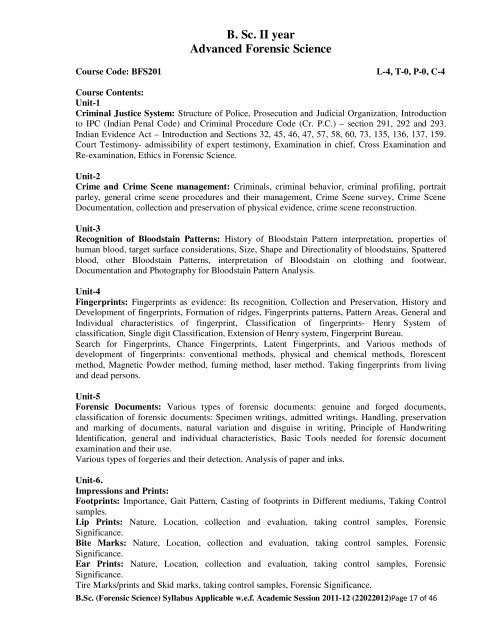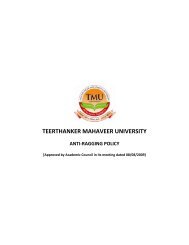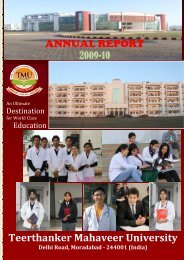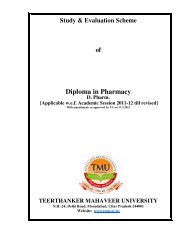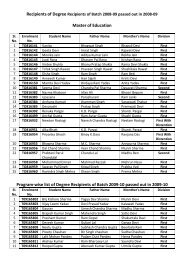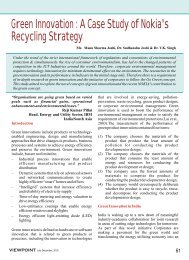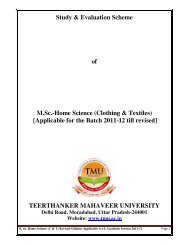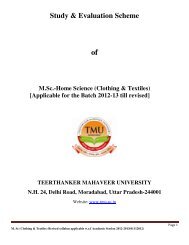Study & Evaluation Scheme of Bachelor of Science in Forensic ...
Study & Evaluation Scheme of Bachelor of Science in Forensic ...
Study & Evaluation Scheme of Bachelor of Science in Forensic ...
Create successful ePaper yourself
Turn your PDF publications into a flip-book with our unique Google optimized e-Paper software.
B. Sc. II year<br />
Advanced <strong>Forensic</strong> <strong>Science</strong><br />
Course Code: BFS201 L-4, T-0, P-0, C-4<br />
Course Contents:<br />
Unit-1<br />
Crim<strong>in</strong>al Justice System: Structure <strong>of</strong> Police, Prosecution and Judicial Organization, Introduction<br />
to IPC (Indian Penal Code) and Crim<strong>in</strong>al Procedure Code (Cr. P.C.) – section 291, 292 and 293.<br />
Indian Evidence Act – Introduction and Sections 32, 45, 46, 47, 57, 58, 60, 73, 135, 136, 137, 159.<br />
Court Testimony- admissibility <strong>of</strong> expert testimony, Exam<strong>in</strong>ation <strong>in</strong> chief, Cross Exam<strong>in</strong>ation and<br />
Re-exam<strong>in</strong>ation, Ethics <strong>in</strong> <strong>Forensic</strong> <strong>Science</strong>.<br />
Unit-2<br />
Crime and Crime Scene management: Crim<strong>in</strong>als, crim<strong>in</strong>al behavior, crim<strong>in</strong>al pr<strong>of</strong>il<strong>in</strong>g, portrait<br />
parley, general crime scene procedures and their management, Crime Scene survey, Crime Scene<br />
Documentation, collection and preservation <strong>of</strong> physical evidence, crime scene reconstruction.<br />
Unit-3<br />
Recognition <strong>of</strong> Bloodsta<strong>in</strong> Patterns: History <strong>of</strong> Bloodsta<strong>in</strong> Pattern <strong>in</strong>terpretation, properties <strong>of</strong><br />
human blood, target surface considerations, Size, Shape and Directionality <strong>of</strong> bloodsta<strong>in</strong>s, Spattered<br />
blood, other Bloodsta<strong>in</strong> Patterns, <strong>in</strong>terpretation <strong>of</strong> Bloodsta<strong>in</strong> on cloth<strong>in</strong>g and footwear,<br />
Documentation and Photography for Bloodsta<strong>in</strong> Pattern Analysis.<br />
Unit-4<br />
F<strong>in</strong>gerpr<strong>in</strong>ts: F<strong>in</strong>gerpr<strong>in</strong>ts as evidence: Its recognition, Collection and Preservation, History and<br />
Development <strong>of</strong> f<strong>in</strong>gerpr<strong>in</strong>ts, Formation <strong>of</strong> ridges, F<strong>in</strong>gerpr<strong>in</strong>ts patterns, Pattern Areas, General and<br />
Individual characteristics <strong>of</strong> f<strong>in</strong>gerpr<strong>in</strong>t, Classification <strong>of</strong> f<strong>in</strong>gerpr<strong>in</strong>ts- Henry System <strong>of</strong><br />
classification, S<strong>in</strong>gle digit Classification, Extension <strong>of</strong> Henry system, F<strong>in</strong>gerpr<strong>in</strong>t Bureau.<br />
Search for F<strong>in</strong>gerpr<strong>in</strong>ts, Chance F<strong>in</strong>gerpr<strong>in</strong>ts, Latent F<strong>in</strong>gerpr<strong>in</strong>ts, and Various methods <strong>of</strong><br />
development <strong>of</strong> f<strong>in</strong>gerpr<strong>in</strong>ts: conventional methods, physical and chemical methods, florescent<br />
method, Magnetic Powder method, fum<strong>in</strong>g method, laser method. Tak<strong>in</strong>g f<strong>in</strong>gerpr<strong>in</strong>ts from liv<strong>in</strong>g<br />
and dead persons.<br />
Unit-5<br />
<strong>Forensic</strong> Documents: Various types <strong>of</strong> forensic documents: genu<strong>in</strong>e and forged documents,<br />
classification <strong>of</strong> forensic documents: Specimen writ<strong>in</strong>gs, admitted writ<strong>in</strong>gs, Handl<strong>in</strong>g, preservation<br />
and mark<strong>in</strong>g <strong>of</strong> documents, natural variation and disguise <strong>in</strong> writ<strong>in</strong>g, Pr<strong>in</strong>ciple <strong>of</strong> Handwrit<strong>in</strong>g<br />
Identification, general and <strong>in</strong>dividual characteristics, Basic Tools needed for forensic document<br />
exam<strong>in</strong>ation and their use.<br />
Various types <strong>of</strong> forgeries and their detection. Analysis <strong>of</strong> paper and <strong>in</strong>ks.<br />
Unit-6.<br />
Impressions and Pr<strong>in</strong>ts:<br />
Footpr<strong>in</strong>ts: Importance, Gait Pattern, Cast<strong>in</strong>g <strong>of</strong> footpr<strong>in</strong>ts <strong>in</strong> Different mediums, Tak<strong>in</strong>g Control<br />
samples.<br />
Lip Pr<strong>in</strong>ts: Nature, Location, collection and evaluation, tak<strong>in</strong>g control samples, <strong>Forensic</strong><br />
Significance.<br />
Bite Marks: Nature, Location, collection and evaluation, tak<strong>in</strong>g control samples, <strong>Forensic</strong><br />
Significance.<br />
Ear Pr<strong>in</strong>ts: Nature, Location, collection and evaluation, tak<strong>in</strong>g control samples, <strong>Forensic</strong><br />
Significance.<br />
Tire Marks/pr<strong>in</strong>ts and Skid marks, tak<strong>in</strong>g control samples, <strong>Forensic</strong> Significance.<br />
B.Sc. (<strong>Forensic</strong> <strong>Science</strong>) Syllabus Applicable w.e.f. Academic Session 2011-12 (22022012)Page 17 <strong>of</strong> 46


